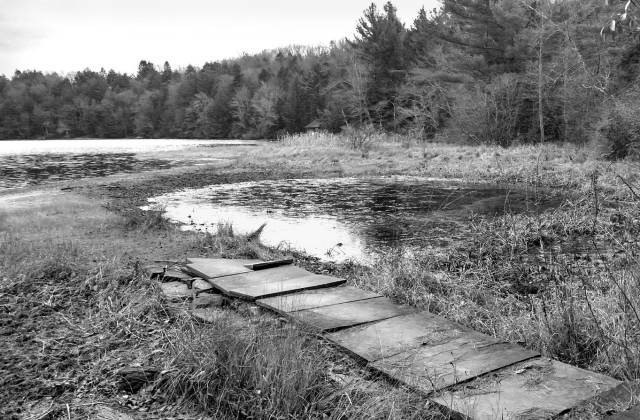It’s Only Natural—February 2016
A Legacy of Conservation
By Hans M. Carlson
The end of 2015 was dry, and before all the recent rain and snow the swamps and ponds were very low. It was nice to walk dry-shod into new places, but ecologically the low water in the wetlands was worrisome. So many amphibians rely on being underwater to survive the winter, and the low water table put stress on the whole system.
Yet the low water also offered an opportunity for reading parts of the landscape that you usually can’t see. Tobey Pond is back to normal now, with water trickling over the spillway, but earlier, not too far from there, earthen berms had emerged with the lowering water level. The earthwork delineated small, rather curious-looking lagoons along the shore, and these offered a clue to part of the early work at Great Mountain Forest.
Unlike stone walls and colliers’ hearths, and the many other remnants of farming and charcoaling, these structures are a vestige of conservation work, not settlement and industry. This alone makes them interesting, but their story reaches out beyond Norfolk, and is more interesting yet. We think of Tobey as a place for recreation, but a hundred years ago other things were happening there worth knowing.
“Tobey Pond looks like a lake in a zoological park,” wrote Frederic C. Walcott to a friend in 1912. “We have from two to five hundred ducks there all the time now; they have stopped over on their way South, attracted by our own ducks, numbering now more than two hundred and representing fourteen different varieties.” By “our own ducks” he meant local birds, but also those brought back from Canada, and this is part of that larger story.
Walcott and Starling W. Childs, who established the conservation effort here at GMF, had paid professionals to travel north and bring back young ducks – canvasbacks, redheads and pintails, among others. These were bred in captivity, and the earthwork is what is left of the pens built for these new residents. It is also a reminder of the two men’s original intent, which was to run a game preserve.
Forest management at GMF, aimed at the health of the whole, began as game management. The objective was to bring back certain birds and animals, and the berms, along with the presence of imported Canadian birds, are a reminder of how depleted this region was at the time. Waterfowl, deer and much other wildlife were on the verge of being regionally extinct a hundred years ago, and this regional issue was also part of the work here.
Childs and Walcott brought the Connecticut Forest, Fish and Game Commission to see Tobey Pond and all the new wildlife in the growing forest. They, along with others, like Alain and May White, who founded White Memorial Forest, lobbied to get the state to acquire public land for similar purposes. Part of the origin story of state forests and parks in Connecticut is thus held in those earthen rings beneath Tobey Pond.
Walcott went into politics and in 1929 became one of Connecticut’s United States senators. He took his conservation interests to Washington and was involved in a variety of efforts, although wildlife and particularly waterfowl remained a focus. The ecological disaster of the Dust Bowl caused huge disruptions in both the breeding and the migration of geese and ducks, and by 1934 it was estimated that there were as few as 30 million left in the entire United States.
Walcott was instrumental in passing the Migratory Bird Hunting Stamp Act that year. Since then, hunters have been required to buy a stamp each year to aid conservation, and to date more than 800 million dollars have been raised to protect more than 6.5 million acres of habitat. Walcott also worked with Franklin D. Roosevelt in creating the Civilian Conservation Corp, which carried out a great deal of wetlands rehabilitation and protection.
Wildlife in the Northwest Corner is plentiful to the point of being nearly unnoteworthy today, but the berms on Tobey Pond help tell the story of a time when that wasn’t the case. They are a piece of the conservation legacy here in the forest—the on-the-ground effort to bring the region back—and a small reminder of the political legacy connected to that recovery as well.
Photo by Abby Burbank.

